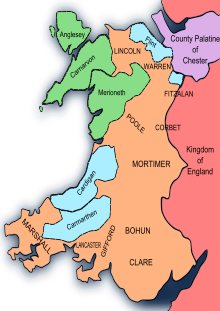Statute of Rhuddlan
The statute of Rhuddlan was issued by King Edward I of England after the conquest of Wales on March 3, 1284. On March 19, 1284, it was promulgated in Rhuddlan Castle in North Wales.
For Wales the law mainly meant the annexation of the country by England and the introduction of English law in place of traditional Welsh law. However, the law only applied to the former principality of Gwynedd , which became part of the new English principality of Wales , and not to the baronies of the Welsh Marches , in which the Marcher Lords continued to rule largely autonomously.
The law divided the Principality of Wales into the counties of Flintshire , Anglesey , Caernarfonshire , Merionethshire , Cardiganshire and Carmarthenshire . The offices of sheriff , coroner, and bailiff were established in the counties . A justiciar was appointed for Wales to oversee the observance of the peace.
For this purpose, English common law was introduced in the Principality of Wales , but it was adapted to Welsh customs in some points such as inheritance law. However, under the new law, illegitimate sons were excluded from the inheritance.
The statute was in force until the Incorporation of Wales Acts by Henry VIII .
literature
- Rees R. Davies: The Age of Conquest. Wales 1063-1415. Oxford University Press, Oxford 1991, ISBN 0-19-820198-2
- Llinos Beverley Smith: The Statute of Wales, 1284 . In: Welsh history review, 10 (1980), pp. 127-154
Individual evidence
- ^ David Walker: Medieval Wales . Cambridge University Press, Cambridge 1990. ISBN 978-0-521-31153-3 , p. 139
